This story, by Fukushima Central Television, Co., Ltd., was published in partnership with HuffPost Japan and is translated from the original Japanese footage.
March 11, 2011. A pregnant woman about to give birth was filled with unprecedented anxiety. When the nuclear accident occurred in Fukushima, Japan, 11 years ago, she had to give birth while worrying about radiation.
She underwent an emergency cesarean section at a hospital in the disaster area immediately after the explosion at the nuclear power plant, and the procedure was recorded on video. Although evacuation was ordered by the Japanese government, a team of doctors and midwives stayed behind at the hospital to facilitate and support the birth of a small life. This new life was hope itself, for all of us at a time when people were unable to see the future due to the despair caused by the earthquake, tsunami and nuclear accident.
Japan Hit By Its Largest Earthquake
Eleven years ago, Kahori Tsukamoto, who was 29 years old at the time, was about to give birth to her long-awaited first baby at Minamisoma Municipal General Hospital, about 14 miles (23 kilometers) from Fukushima Daiichi nuclear power plant. She had been living in Osaka for work but, in keeping with Japanese tradition, had returned to her hometown of Minamisoma with her husband, Kenta, to give birth.
At 2:46 p.m. on March 11, five days after the original due date, the hospital was hit by a strong tremor from the magnitude 9.0 earthquake. At that moment, Tsukamoto was being administered medicine to induce delivery.
“At first, I thought it was a small earthquake, but it became bigger and bigger. A nurse was holding the bed throughout the shaking but I felt like I was about to be thrown off. I thought the hospital would collapse,” she said.
At that time, 108 patients, including Tsukamoto, were hospitalized in the seven-story hospital. After the earthquake hit, the doctors and nurses moved all patients to the first floor, to enable a quick exit should the building collapse. The labor-inducing medicine was immediately stopped for Tsukamoto, who was on the third floor, and she escaped to her husband’s car in the hospital parking lot.
She wanted to stay there until aftershocks subsided, but an ashen-faced hospital staff member knocked on the car door and said, “A tsunami is coming!”
The staff moved all patients from the first floor to the top floor again; the hospital is located only 1.9 miles (3 kilometers) from the coast. Although the hospital wasn’t hit by the tsunami, the sight of the city from the top floor completely changed in front of their eyes as 1,522 households were swallowed by the waves.
Hydrogen Explosion During Labor And A Doctor’s Decision
The next day, a hydrogen explosion occurred at Fukushima Daiichi Nuclear Power Plant Unit 1. Tsukamoto’s anxiety reached new heights, and she worried that “if radiation spreads, it may affect my baby.”
The government issued an evacuation order for the areas around the nuclear power plant, and the hospital was to accept many patients from that area. To make room for these new patients, existing patients who were able to move on their own were asked to evacuate.
Tsukamoto’s family home is less than half a mile (500 meters) away from the hospital, and she had to stay there until it was time to give birth.
Everyone in that area was instructed to stay indoors, and some people started leaving the city.
Around 5 p.m. on March 13, Tsukamoto’s water broke, and she returned to the hospital. Since it was her first birth and due to her extreme anxiety, the labor didn’t go smoothly. Tsukamoto couldn’t sleep, and she felt almost crushed by fear. She apologized to the baby inside her, saying, “I’m sorry for scaring you,” and staring at the ceiling of the hospital room.
Then, at 11:01 a.m. on March 14, when her labor pains were finally getting stronger, another hydrogen explosion occurred at the power plant, this time in Unit 3.
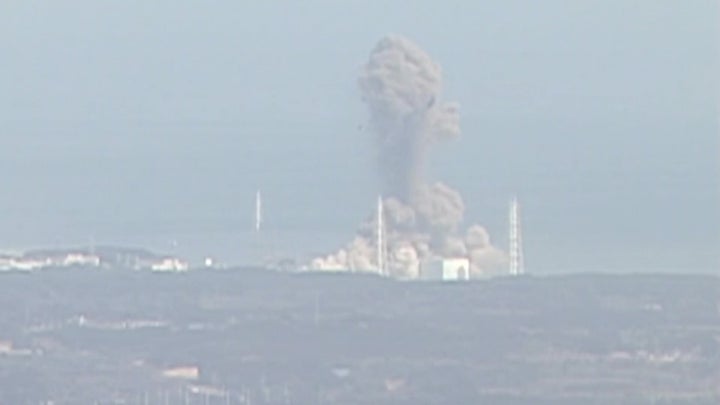
The obstetrician, Dr. Hiroshi Anbe, who was 39 years old at the time, decided to conduct an emergency cesarean section.
“All staff were contacted and informed that they could evacuate if they want to. We had considered evacuating after the Unit 3 explosion but I decided that Kahori Tsukamoto should give birth, even if it were via surgery,” Anbe said.
A Birth Surrounded By Radiation Suits
A “declaration of dissolution” was made. Hospital staff have families of their own. Tough decisions were made in many offices and schools in Fukushima. Many staff, and some patients who were able to move, prepared to leave. However, the light of an operating room was switched on. A skeleton staff, including Anbe, a nurse, and a midwife, delivered Tsukamoto’s baby.
Anbe was married and had two kids, with a third on the way. He made sure that his family evacuated from the city while he chose to stay behind and support the birth of the small life in his hospital.
Only 56 minutes after the Unit 3 explosion, Tsukamoto gave birth to a 6 pound, 5 ounce (2870 gram) boy. Her heart had been almost torn that she would not be able to deliver safely. However, she breathed a huge sigh of relief once she saw her newborn baby sleeping peacefully.
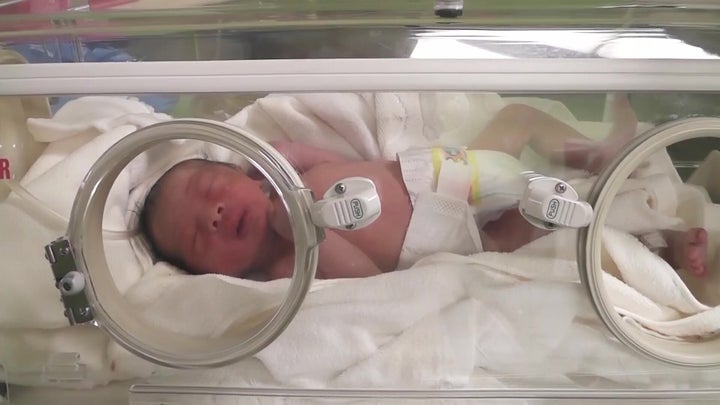
Tsukamoto handed a video camera to the midwife just before her delivery and asked them to record. In the video, recorded immediately following the procedure, are Tsukamoto, Anbe, a nurse and the midwife. The staff are waving their hands with smiles but they are all wearing something that looks like a white jumpsuit. It’s a suit that protects against radiation.
In the video, the midwife asks, “What date is it today, Mom?”
“It’s March 14th,” Tsukamoto replies.
The midwife responds, “Baby boy, please watch this video when you grow up. Well done! Never give up, no matter what happens!”
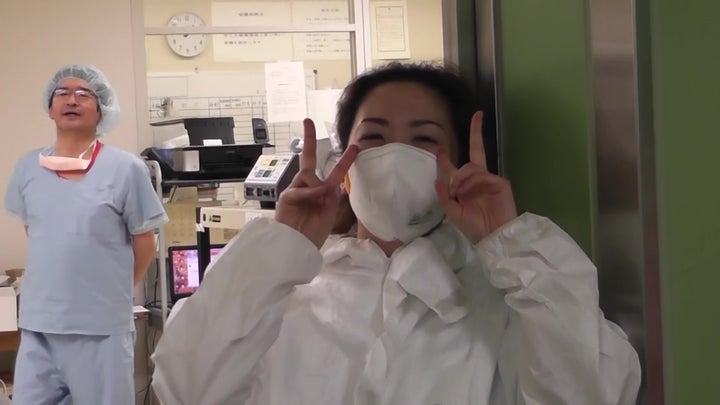

Anbe and his colleagues fulfilled their mission of bringing life into this world despite having been ordered to evacuate. He recalls that he followed his feelings as a parent of small children in that extreme situation.
“We were all worried about our own families. Still, it’s the instinct of parents to protect their own children. That’s why we made a huge effort to deliver the baby in front of us,” he said.
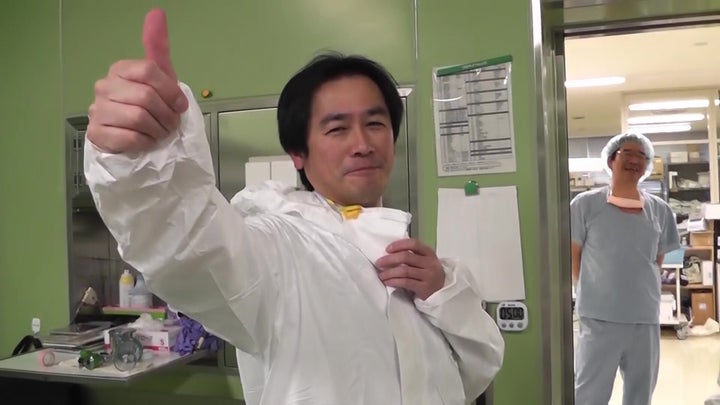
After delivering the baby, Anbe evacuated from the city to rejoin his family, but in the following year he returned to Minamisoma. To this day, he continues to deliver babies in the area where 636 people were killed by the tsunami, and where many others lost their lives, jobs or livelihoods due to radiation.
“These children are the hope of Fukushima. They are the ones who will save their damaged hometown and I feel that steps have been made toward recovery,” he said.
As long as there are families who want to give birth and raise children in Fukushima, there is a future. Anbe pins his hopes on the lives that have been, and will be, born in Fukushima.
“People who were born and/or raised here should not forget what happened in Fukushima, and I want them to pass on the lessons they have learned to others.”
Mother Worries Her Fear Affected Her Son
Tsukamoto now lives with her family, which has increased to four. Even today, she still tears up when she recalls the fear she felt at the time, and when she thinks about the gratitude she has for the doctors who delivered her child.
“Everyone took care of me right until the end. I think they had a lot of worries, but I’m incredibly grateful,” she said.
She still has the video camera that recorded that moment over a decade ago, because she wants to show it to her son. His name is Kenshiro.
Tsukamoto returned to Osaka after Kenshiro was born, and she thought they could live without worries about radiation. However, he was shy when he was little and often cried because he couldn’t do the same things as everyone else. Every time this happened, Tsukamoto wondered if her son’s character might have been affected by her sense of fear during the disaster. She repeatedly blamed herself.
One day, when he was 8 years old, Kenshiro said, “I want to play baseball!” Tsukamoto was surprised, but she thought it would be good for him to have more friends, and she let him join a local youth baseball team.
After that, he gradually became more outgoing and adventurous. His teacher at the primary school said, “Kenshiro is cheerful and always makes his classmates smile.” The midwife’s message on the day of his birth may be fulfilled: Never give up, no matter what happens.
However, Kenshiro, who is growing up in Osaka, actually didn’t know what the situation was like when he was born. He said, “I was born in Minamisoma city, maybe.” Nor did he know about the nuclear accident that happened in Fukushima in 2011, or about the medical staff.
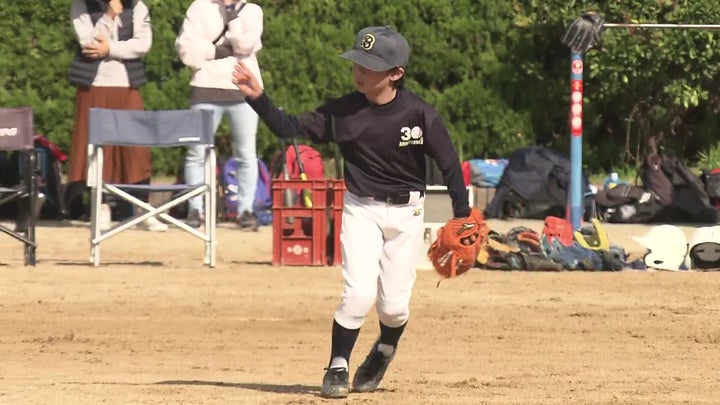
At Age 10, Kenshiro Watches Video Of His Birth
Tsukamoto now believes that Kenshiro is old enough to understand. Last year, 10 years following the disaster, she decided to show him the video of his birth.
She broached the subject after dinner one evening. She said, “Let’s watch something on the TV. It’s a video of you when you were just born.” Kenshiro was surprised. He exclaimed, “I didn’t know such a video existed!” He stared at the screen with a kind of embarrassed smile.

They heard the midwife’s joyful voice. “Congratulations! It’s March 14th. You did an amazing job in such awful circumstances. Have you decided on a name?”
Tsukamoto, lying on the stretcher, replied, “We’re naming him Kenshiro.” Then the midwife says, “Kenshiro, please watch this when you grow up. Never give up, no matter what happens!“
Kenshiro never took his eyes off the screen. There was an unusual sense of urgency. After finishing the video, he asked with a serious look. “Were the people in Fukushima upset at that time?” His father, Kenta, slowly and gently explained about the nuclear accident, as well as about Dr. Anbe and the other staff who stayed behind.
“Well, it was very confusing moment. You were striving to live when everyone was wondering if the nuclear power plant had exploded and whether they were going to die. You were born because everyone helped you,” he said.
“Then, if they hadn’t helped me ...” Kenshiro murmured and stared at his parents’ faces with a worried look. His birth was supported by doctors in an extreme situation. His mother’s feeling on that day when she realized that people could never live alone gradually seemed to reach her son’s heart.
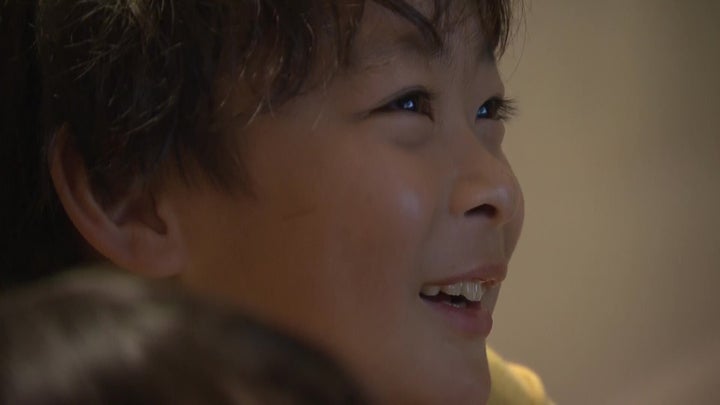
Kenshiro’s parents are thinking of taking their son to Minamisoma someday, to see what the current-day city is like.
A message from Fukushima Central Television:
How important is it to pass on information about the disaster to those born after it occurred? Even for such a shocking accident, opportunities to learn about the event may become fewer as each year passes. We, as media in Fukushima, have an earnest hope. Please listen to the accounts of people who experienced the disaster in March 2011. The thoughts that occurred to these people in the midst of such an extreme situation, thoughts that included preparing for death, should be passed on to future generations, so that the disaster is never forgotten, and lessons can be learned.